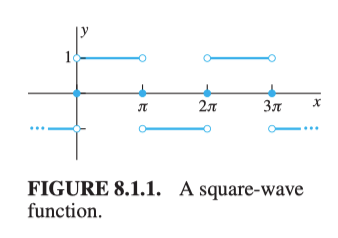Introduction to Fourier Series
June 11, 2019
(Book 8.1)
Continuing from note 24 in Linear Algebra,
Aside from the trigonometric identity that , there’s another way we can get the orthogonality relation such as , we can use DE:
What satisfies this DE? and you may recall this DE from the undamped case. Let be any two different sin or cos functions, ,then
And let’s take have the following:
And
through integration by parts and by listing out all possible cases that may take. And (2) is symmetric, this means we connect (2) to the two integrations in (1), we have:
For , this can only happens when . Only case left is , if we have nothing to prove because they are the same and evaluated to . If:
This finished the proof (what a mess).
Square-wave function
Let’s try to find the Fourier series for the square-wave function. It is on
It has period .

Since it is not continuous from to nor from 0 to , we need to separate the integration.
And
Therefore
Remember is coefficients for , so the Fourier series for the square-wave function is
We can write this $n$ into natural number and rename it into $k$ which I think look better: